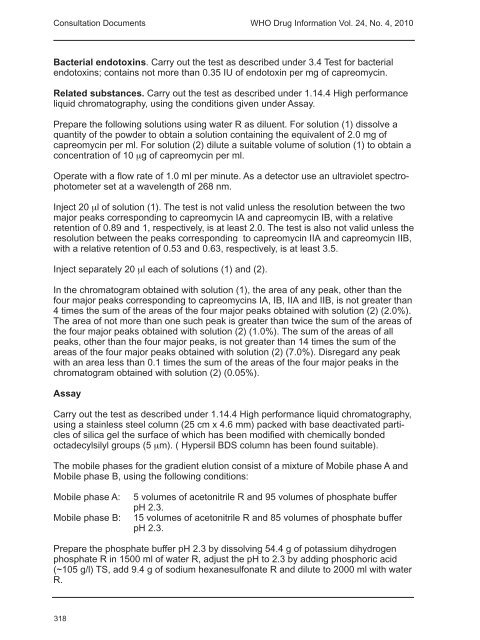WHO Drug Information Vol. 24, No. 4, 2010
WHO Drug Information Vol. 24, No. 4, 2010
WHO Drug Information Vol. 24, No. 4, 2010
Create successful ePaper yourself
Turn your PDF publications into a flip-book with our unique Google optimized e-Paper software.
Consultation Documents<strong>WHO</strong> <strong>Drug</strong> <strong>Information</strong> <strong>Vol</strong>. <strong>24</strong>, <strong>No</strong>. 4, <strong>2010</strong>Bacterial endotoxins. Carry out the test as described under 3.4 Test for bacterialendotoxins; contains not more than 0.35 IU of endotoxin per mg of capreomycin.Related substances. Carry out the test as described under 1.14.4 High performanceliquid chromatography, using the conditions given under Assay.Prepare the following solutions using water R as diluent. For solution (1) dissolve aquantity of the powder to obtain a solution containing the equivalent of 2.0 mg ofcapreomycin per ml. For solution (2) dilute a suitable volume of solution (1) to obtain aconcentration of 10 µg of capreomycin per ml.Operate with a flow rate of 1.0 ml per minute. As a detector use an ultraviolet spectrophotometerset at a wavelength of 268 nm.Inject 20 µl of solution (1). The test is not valid unless the resolution between the twomajor peaks corresponding to capreomycin IA and capreomycin IB, with a relativeretention of 0.89 and 1, respectively, is at least 2.0. The test is also not valid unless theresolution between the peaks corresponding to capreomycin IIA and capreomycin IIB,with a relative retention of 0.53 and 0.63, respectively, is at least 3.5.Inject separately 20 µl each of solutions (1) and (2).In the chromatogram obtained with solution (1), the area of any peak, other than thefour major peaks corresponding to capreomycins IA, IB, IIA and IIB, is not greater than4 times the sum of the areas of the four major peaks obtained with solution (2) (2.0%).The area of not more than one such peak is greater than twice the sum of the areas ofthe four major peaks obtained with solution (2) (1.0%). The sum of the areas of allpeaks, other than the four major peaks, is not greater than 14 times the sum of theareas of the four major peaks obtained with solution (2) (7.0%). Disregard any peakwith an area less than 0.1 times the sum of the areas of the four major peaks in thechromatogram obtained with solution (2) (0.05%).AssayCarry out the test as described under 1.14.4 High performance liquid chromatography,using a stainless steel column (25 cm x 4.6 mm) packed with base deactivated particlesof silica gel the surface of which has been modified with chemically bondedoctadecylsilyl groups (5 µm). ( Hypersil BDS column has been found suitable).The mobile phases for the gradient elution consist of a mixture of Mobile phase A andMobile phase B, using the following conditions:Mobile phase A:Mobile phase B:5 volumes of acetonitrile R and 95 volumes of phosphate bufferpH 2.3.15 volumes of acetonitrile R and 85 volumes of phosphate bufferpH 2.3.Prepare the phosphate buffer pH 2.3 by dissolving 54.4 g of potassium dihydrogenphosphate R in 1500 ml of water R, adjust the pH to 2.3 by adding phosphoric acid(~105 g/l) TS, add 9.4 g of sodium hexanesulfonate R and dilute to 2000 ml with waterR.318

















